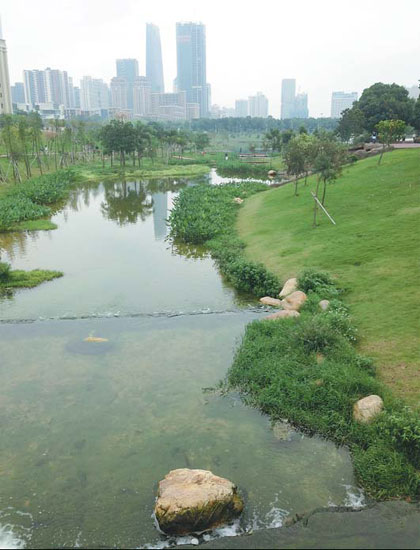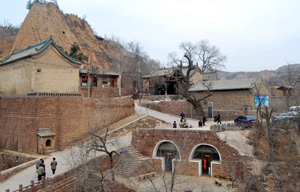Saving urban water
|
Skyscrapers loom over the Futian River after the eco-salvage project from 2008 to 2011. Cang Lide / China Daily |
As a result, rainfall in the rainy season, and almost all sewage water in the dry season have been collected by the system. The water is then diverted to sewage disposal plants and recycled after treatment.
In designing their grand plan, Zhu says the engineers have followed the original designs of nature.
Concrete embankments erected in the past were replaced by rocks and pebbles. Sand, mud and pebbles created long strips of wetland along some parts of the bank.
With some 40 million tons of recycled water drained into the Futian River every year, these wetlands with their thick bushes and weeds have played a vital role in filtering and purifying the water, turning it into a natural, clean water source that is almost as good as natural.
After three years of hard work and 300 million yuan ($49 million), the water quality of the Futian was upgraded from a filthy category IV to a pristine category II.
The standard for flood control has also been raised, reducing the possibility from once in 10 years to once in 100 years.
At the same time, three large scenic lakes have emerged. Lush green plants grow alongside and special greenways have been paved for cyclists and joggers.
From being an eyesore and health hazard, the Futian has become Shenzhen's green lung and its residents' favorite park.
There are more success stories waiting to happen, including ambitious plans for comprehensive water control projects. All are near completion, such as work on the Shenzhen Reservoir, Guanlan River, Houhai River and Longgang River. Work continues on the Qianhai Reclamation project.
In the next two years, Shenzhen is planning to build a catchment area covering 550 square km, with the aim of capturing precious rainwater, and creating additional green space for its inhabitants to commute with nature.
The guiding principles of the Shenzhen eco-salvage water projects are simple: Infrastructure underground must be in direct correlation with development above ground. The best designs follow the natural course. And finally, the environment is the city's best asset and selling point.
Shenzhen has become a city with a beautiful river flowing through it. Hopefully, other major cities in China will look toward its example and learn a thing or two from the Futian River and its protectors.
Pauline D. Loh contributed to the story.
Related:
The transformation of the Futian River
It took three years from 2008 to 2011 to fully complete the eco-salvage of the Futian River, including planning and all civil engineering work. More...
| Big problems in smallest room |





















